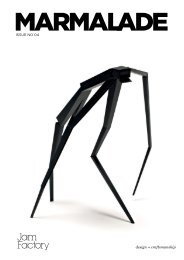Marmalade Issue 5, 2017
You also want an ePaper? Increase the reach of your titles
YUMPU automatically turns print PDFs into web optimized ePapers that Google loves.
Feature<br />
Studio Pottery<br />
Words by Damon Moon<br />
Damon Moon is Creative Director of the Ceramics Studio<br />
at JamFactory.<br />
Throughout most of history, pottery has<br />
been a collective affair that has availed<br />
itself of the level of industry, scale of<br />
production and techniques of manufacture<br />
appropriate to a particular time and place.<br />
The objects that resulted from these endeavours may have<br />
been rudely functional or highly decorative, with their<br />
workplace origins ranging from small rural concerns to<br />
industries encompassing entire cities, as in the group of<br />
six towns that comprised the district of Stoke-on-Trent in<br />
England or the city of Jingdezhen in China, which had a<br />
continuous history of porcelain manufacture and export for<br />
over a thousand years.<br />
In fact, it was only really in the late 19th century, as a<br />
result of the changing nature of art and the influence of<br />
philosophies towards handcrafts espoused by the Arts and<br />
Crafts movement, that a new approach to making came into<br />
being and a new practitioner appeared – the artist or ‘studio<br />
potter’, so named because their workplace resembled an<br />
artist’s studio and the results of their labour edged closer<br />
to the world of art whilst retreating from the practicalities<br />
of industry.<br />
Just when the term ‘studio pottery’ first appeared is unclear,<br />
but what it described went beyond a style of work to<br />
encompass an approach to making and a lifestyle that for<br />
many was – and still is – more vocation than occupation.<br />
That there was a certain element of nostalgia underpinning<br />
this trend is undeniable, however in every era, it seems that<br />
periods of social upheaval and a rapid growth of industry<br />
and technological advancement is augmented by a growth<br />
of interest in making on a small scale, or what may now be<br />
called ‘slow’ making or the ‘makers’ movement’. For every<br />
action there is a reaction.<br />
30 / ISSUE 05











